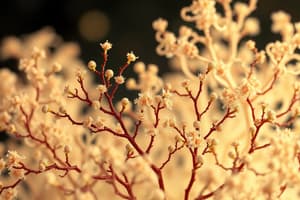Podcast
Questions and Answers
Blood Agar allows identification of ______ activity.
Blood Agar allows identification of ______ activity.
hemolytic
Mannitol Salt Agar is used to differentiate species of ______.
Mannitol Salt Agar is used to differentiate species of ______.
Staphylococcus
Bile Esculin Agar differentiates between Enterococcus and group D ______.
Bile Esculin Agar differentiates between Enterococcus and group D ______.
Streptococcus
Columbia CNA Agar contains antibiotics to suppress ______ bacteria.
Columbia CNA Agar contains antibiotics to suppress ______ bacteria.
Phenylethyl Alcohol Agar inhibits the growth of ______ bacteria.
Phenylethyl Alcohol Agar inhibits the growth of ______ bacteria.
Flashcards are hidden until you start studying
Study Notes
Differential Media for Gram + Coccus
-
Purpose: Differentiate between various types of Gram-positive cocci based on metabolic characteristics.
-
Examples:
-
Blood Agar:
- Contains sheep blood; supports growth of most bacteria.
- Allows identification of hemolytic activity (alpha, beta, gamma hemolysis).
-
Mannitol Salt Agar (MSA):
- High salt concentration favors Staphylococcus species.
- Contains mannitol; S. aureus ferments mannitol, turning the medium yellow.
-
Bile Esculin Agar:
- Contains bile salts and esculin; differentiates Enterococcus and group D Streptococcus.
- Positive reaction indicated by dark brown color due to esculetin production.
-
Selective Media for Gram + Coccus
-
Purpose: Inhibit the growth of unwanted Gram-negative bacteria while promoting the growth of Gram-positive cocci.
-
Examples:
-
Columbia CNA Agar:
- Contains antibiotics (colistin and nalidixic acid) to suppress Gram-negative bacteria.
- Supports growth of Gram-positive cocci, especially Streptococci and Staphylococci.
-
Mannitol Salt Agar (MSA):
- Acts as both selective and differential; high salt concentration inhibits non-halophilic organisms.
-
Phenylethyl Alcohol Agar (PEA):
- Phenylethyl alcohol inhibits Gram-negative bacteria.
- Supports the growth of Gram-positive cocci, particularly Staphylococci and Streptococci.
-
Summary
- Use differential media to distinguish between species based on specific metabolic capabilities.
- Use selective media to isolate and promote the growth of Gram-positive cocci while inhibiting Gram-negative bacteria.
Differential Media for Gram + Coccus
- Purpose: Differentiates types of Gram-positive cocci based on metabolic characteristics.
- Blood Agar:
- Composed of sheep blood; supports growth of most bacteria.
- Identifies hemolytic activity: alpha (partial), beta (complete), gamma (none) hemolysis.
- Mannitol Salt Agar (MSA):
- High salt concentration selectively favors Staphylococcus species.
- Contains mannitol; fermentation by S. aureus results in yellow coloration of the medium.
- Bile Esculin Agar:
- Comprises bile salts and esculin; distinguishes Enterococcus and group D Streptococcus.
- Positive result is indicated by dark brown coloration due to esculetin production.
Selective Media for Gram + Coccus
- Purpose: Inhibits growth of Gram-negative bacteria while promoting Gram-positive cocci growth.
- Columbia CNA Agar:
- Contains antibiotics (colistin and nalidixic acid) to prevent Gram-negative bacterial growth.
- Particularly supports Streptococci and Staphylococci.
- Mannitol Salt Agar (MSA):
- Functions as both selective and differential; excessive salt inhibits non-halophilic organisms.
- Phenylethyl Alcohol Agar (PEA):
- Incorporates phenylethyl alcohol to suppress Gram-negative bacteria.
- Facilitates growth of Gram-positive cocci, particularly Staphylococci and Streptococci.
Summary
- Differential media is essential for distinguishing species based on metabolic capabilities.
- Selective media isolates and promotes Gram-positive cocci while inhibiting Gram-negative bacteria.
Studying That Suits You
Use AI to generate personalized quizzes and flashcards to suit your learning preferences.



